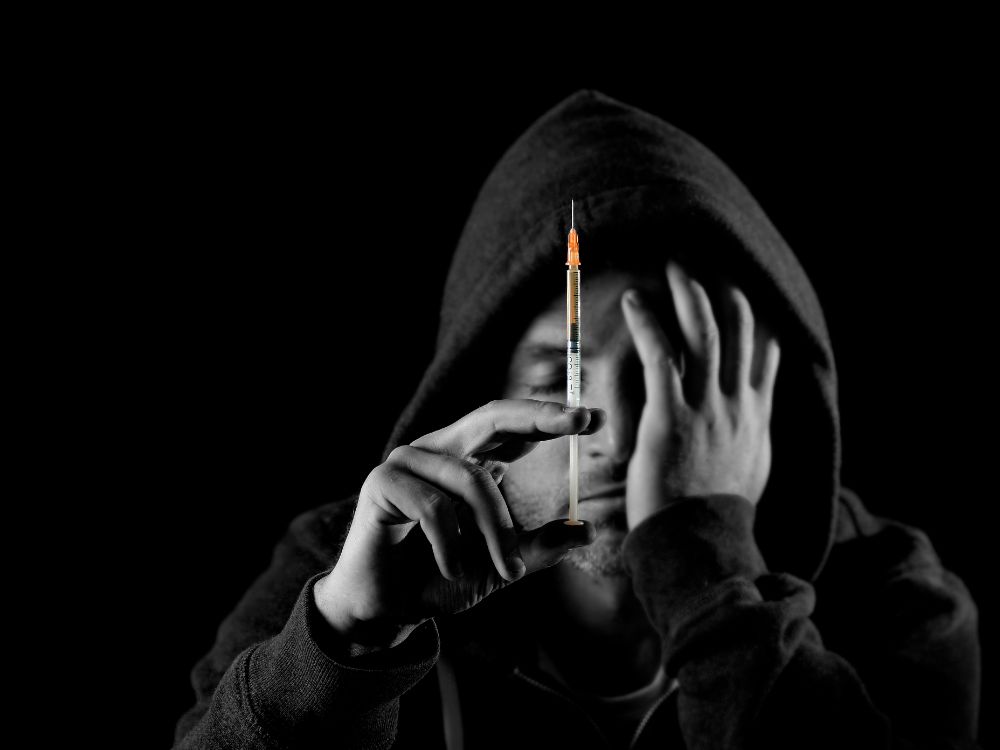How to Recognize Heroin Addiction?

Being able to recognize a heroin addiction is important, as it can enable you to help someone who may be struggling with addiction. Knowing the information in the following passage will enable you to identify and help resolve the signs and symptoms of heroin addiction.
What is Heroin?
Heroin is an opioid narcotic that is created from morphine, a natural chemical extracted from the seed pod of numerous opium poppy plants that are grown in Southeast and Southwest Asia, Mexico, and Colombia. It is a depressant of the central nervous system. Black tar heroin is a sticky black material that can be either white, brown, or black powder in color. It is a drug that has a high potential for abuse, and heroin users suffer some of the worst withdrawal symptoms, which are known as heroin withdrawal.
How do People Use Heroin?
Heroin is injected into the veins, snorted, or smoked. It is also a popular combination to crack cocaine which is known as speedballing.
Effects of heroin
Heroin quickly enters the brain and attaches to opioid receptors on cells in numerous regions, including those in charge of regulating heart rate, sleep, and breathing as well as pain and pleasure perception.
Temporary Effects
Heroin users claim to experience a “rush” (a surge of pleasure or euphoria). However, there are more general effects, such as:
- dry mouth
- heated skin flushing
- heaviness in the arms and legs
- intense itching and nausea,
- Confused mental function, and “on the nod,” a fluctuating state of consciousness and semiconsciousness
Longterm Effects
Long-term h users may experience the following side effects:
- Insomnia Damaged tissue inside the nose for those who sniff or snort it Collapsed veins for those who inject it
- Abscesses and infection of the heart’s valves (swollen tissue filled with pus)
- Abdominal pain and diarrhea
- A liver and kidney condition
- Pneumonia among the lung conditions
- Sadness and antisocial personality disorder are examples of mental illnesses
- Male sexual dysfunction
- Irregular women’s menstrual cycles
Additional Potential Risks
Heroin frequently contains additives that might clog blood vessels in the lungs, liver, kidneys, or brain, resulting in long-term harm. Examples of these additions include sugar, starch, and powdered milk. Additionally, drug usage that impairs judgment and sharing drug injection equipment both raise the risk of developing infectious diseases like HIV and hepatitis.
These diseases are seen more in people with heroin addiction. In addition, the chances of a heroin overdose are high as it is hard to determine the potency of the drug without proper equipment, making it very easy to take more than you are supposed to.
Signs and Symptoms of Heroin Addiction
Based on individual characteristics, the duration of consumption, the presence of mental diseases, and the use of other drugs, the signs and symptoms of heroin misuse will greatly differ from person to person. The following are the most typical warning signs and symptoms of heroin abuse:
- Snoozing unexpectedly
- Breathing more slowly
- Mouth ache
- Blotchy skin
- An increase in sleep
- Alterations in diet Loss of weight
- Ongoing stuffy nose
- decreased capacity to address problems
- Illogical thinking
- Decision-making skills deteriorated
- Disorientation
- Lack of self-control Inability to focus in class Short-term memory impairment
- Mental and social symptoms
- Surges of happiness
- Unforeseen changes in personality or outlook
- Abrupt mood changes
- Furious outbursts
- Irritability
- a lack of drive
- greater paranoia
If you see any of these symptoms signs in your loved ones, they may be battling heroin addiction. It would be best to help them seek treatment, as heroin abuse can lead to being fatal. Where heroin withdrawal is unsettling, it is always worth it to beat addiction to heroin.
Effects of a Heroin Overdose
The opioid overdose triad is a term used by medical experts to describe some of the most obvious symptoms of a heroin overdose. These three symptoms are pin-point-sized pupils, a dramatic decline in the degree of consciousness, and respiratory depression, which is a common sight in heroin dens where heroin abuse takes place. These aren’t the only warning signs and symptoms of a heroin overdose, though. There may also be additional signs of a
heroin overdose, such as:
- Uncontrollable vomiting
- Fatigue and sleepiness
- The body becomes limp.
- Loss of consciousness
- Inability to awaken the subject, despite the application of painful stimulation, such as rubbing the sternum with the knuckles
- Making noises close to choking or gurgling
- Inadequate or difficult breathing
- Irregular pulse and heart rhythm
- Reduced blood pressure
- Pale, blue, clammy, and/or cold skin
- Complete cessation of breathing
Statistics for heroin addiction
It’s a common misconception that heroin is a drug that only affects certain social classes and demographic groups. Heroin abusers range from the extremely wealthy to the extremely powerful. The following are some figures and information about heroin addiction and abuse:
- National Survey on Drug Use and Health says that, almost 5.1 million individuals used heroin in 2015.
- The misuse of heroin has epidemic proportions. The National Institute on Drug Abuse reports that between 2002 and 2015, the number of overdose deaths climbed by more than six times.
- According to a recent JAMA Psychiatry study, white Americans experienced the most increase in heroin usage between 2001 and 2013. The survey also discovered that younger adults (18–29) and persons in their mid-life (30–44) are more prone than older adults to use heroin.
- According to a piece from The Atlantic that includes research quotes, heroin use has surged among women, those in better income categories, and those with private insurance. As a result of overdoses, men are more likely than women to die.
Causes and Risk Factors for Overdose
Anyone, even first-time users of the drug, is susceptible to an overdose. However, certain individuals may be more susceptible to overdosing on heroin or other opioids in specific circumstances, such as:
- People who are comparatively younger (i.e., between the ages of 20 and 40).
- Higher chances in males.
- Those who have previously overdosed.
- Those who suffer from serious physical and/or mental illnesses, such as depression, HIV, breathing difficulties, and liver or kidney troubles.
- Intravenously using the drug.
- Those who increase their heroin dosage.
- Using when one’s tolerance to opioids has drastically decreased following a period of sobriety.
- Combining heroin with one or more drugs.
The majority of heroin users also take other drugs, and many of these drug combinations raise the risk of overdose. This danger increases when a person takes heroin together with other CNS depressants like alcohol or benzodiazepines since these substances can exacerbate respiratory slowing and increase the risk of overdose.
Withdrawal Symptoms of Heroin Addiction
The fact that opioids are highly addictive is merely one aspect of the opioid use disorder problem. In addition, there are problems that arise when a person tries to quit using it. With heroin addiction come more severe withdrawal symptoms. The severity of a person’s withdrawal symptoms, which typically begin two days after stopping opioid use, is inversely correlated with the length of time the person has used the substance.
The following are some of the most common withdrawal signs seen when heroin abuse is stopped:
- severe cramping in the stomach
- Concern and sadness
- Sweating
- Hallucination
- Vomiting
Even though the majority of symptoms only persist for about a week, many people decide to keep up with their heroin addiction than cope with the psychological, emotional, and physical side effects of heroin withdrawal.
Treatment for Heroin Abuse
However, treatment for opioid addiction is helpful in assisting patients in overcoming their substance use problem. At Emmaus, Professionals who are knowledgeable about how opioids influence the body and mind help people overcome heroin addiction. Patients will get the support they need with the aid of treatment programs to identify the cause of their heroin addiction and start their path to wellness. Some of the available treatments are as follows:
Outpatient rehabilitation
Depending on the patient’s needs for recovery, several levels of outpatient care offer a more adaptable treatment environment where patients can live at home or in a controlled, sober environment while undergoing treatment. In outpatient therapy, patients typically show up for planned, clinic-based group and individual counseling sessions. This gives them a chance to put what they’ve learned in class into practice outside of therapy sessions and analyze their experiences.
Behavioral therapy
Sessions in individual, group, and family therapy can assist patients in improving communication skills, addressing underlying problems that may have contributed to their addiction, learning coping mechanisms for stressors and triggers, preventing relapse, and fortifying their sobriety.
Medication-assisted therapy (MAT)
Using drugs that can help patients manage cravings and lower their risk of relapsing after the period of medical withdrawal management. These drugs may be used for extended periods of time or indefinitely to help people maintain their difficult recovery.
Emmaus Medical & Counseling provides opioid addiction treatment services for individuals who are addicted to prescription pain medication or heroin. We offer a variety of treatment options, including medication-assisted treatment, as well as inpatient and outpatient programs. We also provide counseling and support services to help you overcome your addiction and maintain sobriety. If you or someone you know is struggling with opioid addiction, please don’t hesitate to call us for help.






